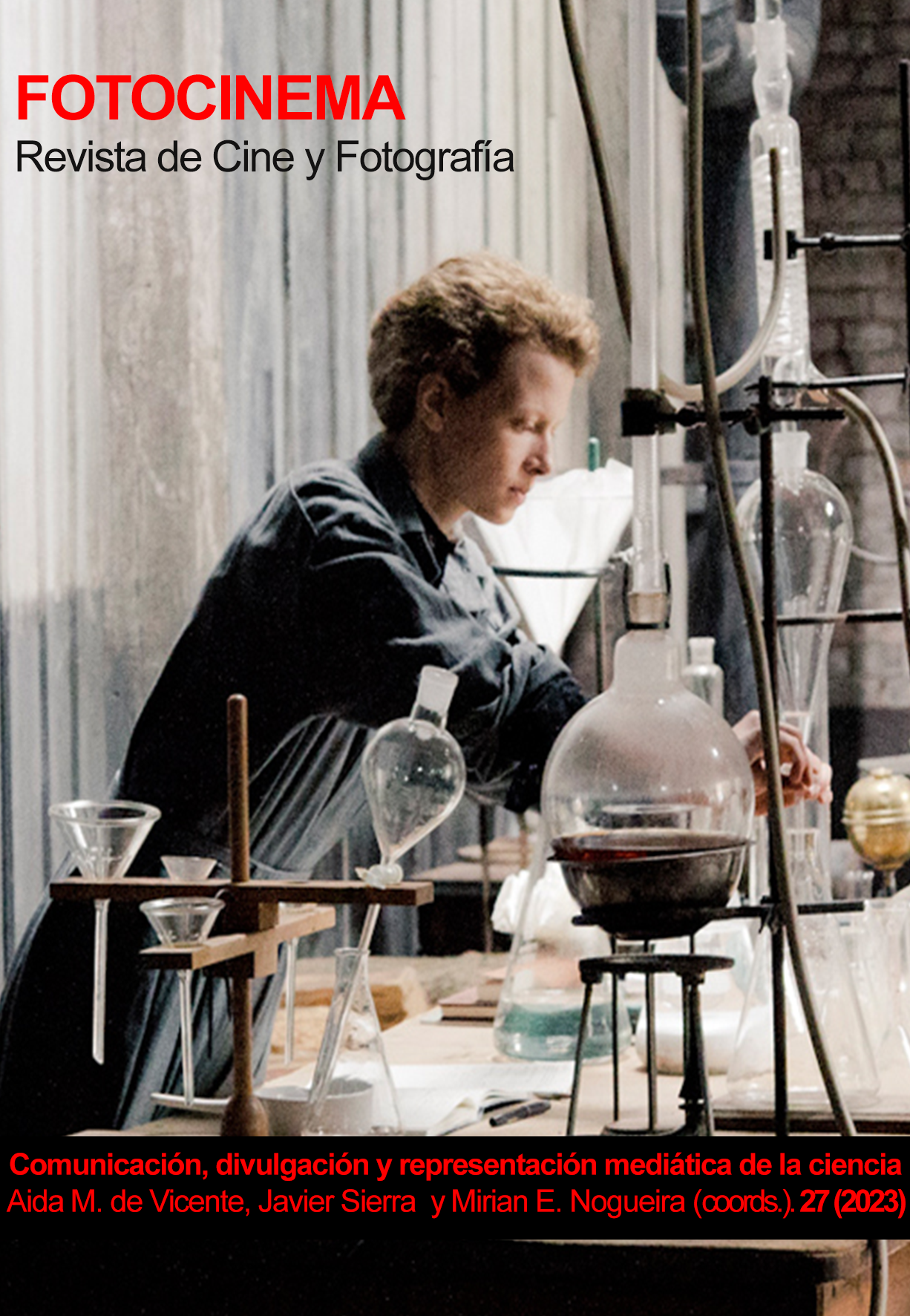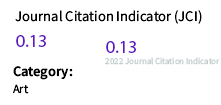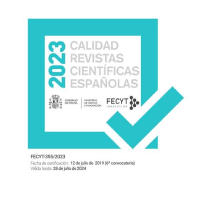The (Impossible) Squaring of the Circle. Pi (Darren Aronofsky, 1998) and the Limits of Scientific Knowledge
DOI:
https://doi.org/10.24310/Fotocinema.2023.vi27.16415Keywords:
Aronofsky, Darren, Modern Science, Cavell, Stanley, Epistemology, Schizofrenia, Film AnaylsisAbstract
This article aims to investigate the critical look that Pi dedicates to the modern scientific imaginary that its protagonist embodies. Based on Stanley Cavell’s ideas and using film analysis, we examine several key scenes in the film that allow us to assess the loss of vital contact with reality that Max suffers as a result of his excessive rationalism. We first evaluate how Max’s desire to achieve an objective and certain mathematical explanation of the universe results in his disconnection from the external world. Next, we weigh the effects of this attitude on his social relations, paying special attention to the (personal and epistemological) confrontation with his teacher. Thirdly, we show how Max is presented as a sort of pure spirit, detached from a body he neglects and conceives as an obstacle. Next, we address the final part of the film in which the protagonist is forced to accept the limits of human knowledge. Finally, and in accordance with the conclusions of our reading of Max’s journey, we underline that the rhetorical strategy of the film emphasizes the somatic condition of the spectator and highlights the need for their hermeneutic participation.
Downloads
Metrics
References
Álvarez, J. M., y Colina, F. (2011). Origen histórico de la esquizofrenia e historia de la subjetividad. Frenia, 9, 2011, 7-26.
Aronofsky, D. (1998). Pi Screenplay & The Guerilla Diaries. Faber and Faber.
Aumont, J., y Marie, M. (1990). Análisis del film. Paidós.
Aumont, J., Bergala, A., Marie, M., y Vernet, M. (1989). Estética del cine. Espacio fílmico, montaje, narración, lenguaje. Paidós.
Baudry, J. L. (1978). L’effet cinema. Albatros.
Bordwell, D. (1996). La narración en el cine de ficción. Paidós.
Bordwell, D., y Thompson, K. (1995). El arte cinematográfico. Paidós.
Burch, N. (1995). El tragaluz del infinito. Cátedra.
Burgos, E. (2018). “Pi, fe en el caos” o cómo suenan las fisuras del orden. Cuadernos de Etnomusicología, 11, 189-202.
Cavell, S. (2003). Reivindicaciones de la razón. Wittgenstein, escepticismo, moralidad y tragedia. Síntesis.
Cavell, S. (2017a). ¿Debemos querer decir lo que decimos?: un libro de ensayos. Prensas de la Universidad de Zaragoza.
Cavell, S. (2017b). El mundo visto. Reflexiones sobre la ontologia del cine. Editorial Universidad de Córdoba.
Chion, M. (1993). La audiovisión: introducción a un análisis conjunto de la imagen y el sonido. Paidós.
Company, J. M., y Marzal, J. J. (1999). La mirada cautiva. Formas de ver en el cine contemporáneo. Generalitat Valenciana.
Eisenstein, P. (2004). Visions and Numbers: Aronofsky's ? and the Primordial Signifier. En T. McGowan y S. Kunkle (Eds.), Lacan and contemporary film (pp. 1-28). Other Press.
Filoseta, R. (2020). Electronic Dance Music in Narrative Film. En M. Filimowicz (Ed.), Foundations in Sound Design for Linear Media: A Multidisciplinary Approach (pp. 327–357). Routledge. https://doi.org/10.4324/9781315106335
Finke, L. A., y Shichtman, M. B. (2012). Truth by the Numbers: Mysticism and Madness in Darren Aronofsky’s ?. En J. K. Sklar y E. S. Sklar (Eds.), Mathematics in Popular Culture Essays on Appearances in Film, Fiction, Games, Television and Other Media (pp. 274-287). McFarland.
Galileo ([1623] 1981). El ensayador. Aguilar.
Gaudreault, A., y Jost, F. (1995). El relato cinematográfico. Paidós.
Gómez Sánchez, A. I., Hellín, P. A., y San Nicolás, C. (2011). Los sentidos de la ciencia en el cine. Metodología para su análisis. Razón y palabra, 78, 1-23.
Gómez Tarín, F. J. (2004). Sistema hegemónico y resistencia. Perspectivas ideológicas y teórico-prácticas en torno a la producción cinematográfica independiente. En J. A. Ruiz Rojo (Ed.), En torno al Cine Aficionado. Actas del II Encuentro de Historiadores – Segundas Jornadas de Cine de Guadalajara (pp. 161-174). Diputación Provincial de Guadalajara.
Heidegger, M. (2010). La época de la imagen mundo. En M. Heidegger, Caminos de bosque (pp. 63-90). Alianza.
Konik, A. (2003). Aronofsky's subversion of mainstream cinema through the neo noir "Pi" (1998). South African Journal of Art History, 18, 38-57.
Kulezic-Wilson, D. (2008). A Musical Approach to Filmmaking: Hip-hop and Techno Composing Techniques and Models of Structuring in Darren Aronofsky’s ?. Music and the Moving Image, 1, 19-34. https://doi.org/10.5406/musimoviimag.1.1.0019
Laine, T. (2017). Bodies in Pain: Emotion and the Cinema of Darren Aronofsky. Berghahn. https://doi.org/10.1093/obo/9780199791286-0305
López Fernández, J. L. (2015). Los científicos del cine. Fotocinema. Revista científica de cine y fotografía, 11, 261-285. https://doi.org/10.24310/Fotocinema.2015.v0i11.6083
Marcuse, H. (2009). The Concept of Essence. En H. Marcuse, Negations: Essays in Critical Theory (pp. 31-64). MayFly.
Marzal, J. J., y Gómez Tarín, F. J. (2007). Interpretar un film. Reflexiones en torno a las metodologías de análisis del texto fílmico para la formulación de una propuesta de trabajo. En J. J. Marzal y F. J. Gómez Tarín (Eds.), Metodologías de análisis del film (pp. 31-56). Edipo.
Nájera, E. (2002). Del alma fuerte al superhombre, Descartes y Nietzsche: dos versiones del sujeto moderno [Tesis doctoral]. Universitat de València.
Perini, E. I. (2015). Max, el hombre de la actualidad. Lindes. Estudios sociales del arte y la cultura, 9.
Prigogine, Y. (2000). ¿Qué es lo que no sabemos?. A Parte Rei. Revista de filosofía, 10, 1-4.
Prigogine, Y., y Stengers, I. (2004). La nueva alianza. La metamorfosis de la ciencia. Alianza.
Sánchez-Biosca, V. (1990). Sombras de Weimar. Contribución a la historia del cine alemán 1918-1933. Verdoux.
Sass, L. (1992). Madness and Modernism: Insanity in the Light of Modern Art, Literature and Thought. Harvard University Press.
Sass, L. (1997). The Consciousness Machine: Self and Subjectivity in Schizophrenia and Modern Culture. En U. Neisser y D. A. Jopling (Eds.), The Conceptual Self in Context: Culture, Experience, Self-understanding (pp. 203-232). Cambridge University Press.
Sass, L., y Parnas, J. (2003). Schizophrenia, Consciousness, and the Self. Schizophrenia Bulletin, 29(3), 427-444. https://doi.org/10.1093/oxfordjournals.schbul.a007017
Simmons, D. C. (2005). The Dysphoric Style in Contemporary American Independent Cinema [Tesis doctoral]. Florida State University.
Skorin-Kapov, J. (2016). Darren Aronofsky’s Films and the Fragility of Hope. Bloomsbury Academic. https://doi.org/10.5040/9781501307003
Woods, A. (2020). Mathematics, masculinity, madness. En G. Araoz e I. Travis (Eds.), Madness in context: historical, poetic and artistic narratives (pp. 101-109). Brill.
Yébenes, Z. (2015). La razón moderna, la razón hechizada. Psicopatología de la superstición en el orden contemporáneo. Dimensión antropológica, 63, 125-155.
Downloads
Published
How to Cite
Issue
Section
License
All contents published in Fotocinema Revista científica de cine y fotografía are protected under the Creative Commons Attribution-NonCommercial-ShareAlike 4.0 International (CC BY-NC-SA 4.0) license. All about this license is available in the following link: <http://creativecommons.org/licenses/by-nc-sa/4.0>
Users can copy, use, redistribute, share and exhibit publicly as long as:
- The original source and authorship of the material are cited (Journal, Publisher and URL of the work).
- It is not used for comercial purposes.
- The existence of the license and its especifications are mentioned.
There are two sets of authors’ rights: moral and property rights. Moral rights are perpetual prerogatives, unrenounceable, not-transferable, unalienable, imprescriptible and inembargable. According to authors’ rights legislation, Fotocinema. Revista científica de cine y fotografía recognizes and respects authors moral rights, as well as the ownership of property rights, which will be transferred to University of Malaga in open access. The property rights are referred to the benefits that are gained by the use or the dissemination of works. Fotocinema. Revista científica de cine y fotografía is published in an open access form and it is exclusively licenced by any means for doing or authorising distribution, dissemination, reproduction, , adaptation, translation or arrangement of works.
Authors are responsable for obtaining the necessary permission to use copyrighted images.










.png)

13.png)




